
We continue, yet again, with AGF’s tank requirements history. We’re now towards the end of 1944, as we rejoin AGF’s attempts to stop Ordnance from telling them what’s best for AGF’s forces.
__________________________________________________
Last of the T23
In order to insure a completely fair evaluation of the T23 tank, Army Ground Forces had proposed in the spring of 1944 to equip the 785th Tank Battalion and expose the tank to extended field service tests in this country. Army Ground Forces was convinced that the tank was not satisfactory but did not want to be in a position of overlooking any advancement which the electric drive might accomplish. Ordnance had claimed that all the initial deficiencies found had been corrected in the ten production models, which were tested by the Armored Board in the summer of 1944. But again results were very disappointing. It was found, for example, that 300 man-hours of maintenance were required for each 100 hours of operation. The track and suspension system was inadequate; the cooling system was easily clogged with dust and prevented satisfactory operation in high ambient temperatures or dusty conditions; no steering or braking was possible if the engine failed, and finally the tank could not be operated satisfactorily at slow speeds without imposing a heavy burden on the traction motors. The Board listed 26 urgent deficiencies in this vehicle. Army Ground Forces approved the Board’s recommendation for a correction of these deficiencies and stated that if they were corrected two battalions would be equipped with the tank and sent to the theater. It was also found in the field test of the tank by the 785th Tank Battalion that the armored engine compartment grilles could not withstand even 20mm fire from the ground or plunging fire from aircraft.
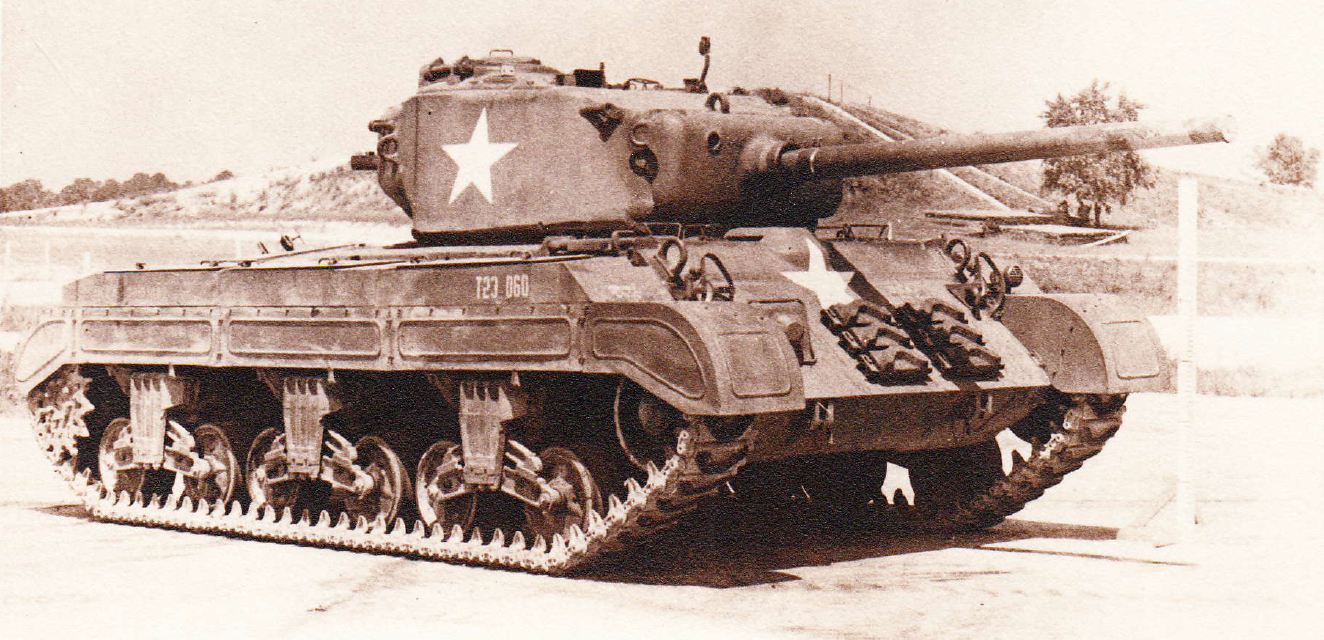
The Ordnance Department admitted that it would be unable to undertake the modifications proposed by Army Ground Forces, but countered with a proposal that one battalion be sent overseas for a combat test of the electric drive. Army Ground Forces agreed only that ETO and MTO be notified of the availability of 150 of these tanks and be provided with full copies of the test reports. The War Department thought that the tank could be used for training, but Army Ground Forces pointed out the many objections to this proposal. After the January 1945 conference on the M6 and T23 tanks, the War Department decided not to send these tanks to the theater and directed that one company be equipped for further test and that the remainder was salvaged.
The Ordnance Department was not content to accept this ruling. It still had some 125 of the tanks on its hands. Ordnance wanted, if possible, to get somebody to say that the tanks were satisfactory. General Barnes went to Europe on a tank mission connected with the introduction of the T26E3 tank in combat. He returned with a report that General Eisenhower suggested using the T23 tank with a 76mm gun, and that all commanders contacted would be happy to have it. Colonel Dean, who accompanied this mission, returned with a directly contrary report. Among those fully informed on the problems incident to using the tank, Colonel Dean could find no one who looked with favor on the proposal. As later substantiated by the comments of the ETO commanders on the Barnes report, it was flatly stated that there was no requirement for the T23, and that it was unlikely that the commanding generals interviewed by General Barnes had personal knowledge of the problems involved, and that their wishes were probably based simply on a desire to get more tanks with 76mm guns.
Thus ended the long history of the T23 tank. What was learned from the production of 250 could have been equally well learned from the first ten pilot models, but such was the urgency ion 1942-1943 of getting promising equipment into large-scale production at once.
Heavy Tanks T28, T29 and T30
While Army Ground Forces was considering the construction of the M4A3E2 tank as an expedient, and the Ordnance Department was attempting to revive the obsolescent M6 in the spring of 1944, Ordnance proposed a new development for a very heavily armored assault tank designated as Heavy Tank T28. This tank was to weigh in the neighborhood of 80 tons and would mount a 105mm AA gun. Its total width would be 178 inches, but this was reducible to 135 inches by removing outer tracks and outer bogie wheels. The width of the double track was to be 38 inches, so that the unit ground pressure would remain in the neighborhood of 12 pounds per square inch. This tank would carry twelve inches of armor. No turret was provided, and the gun would therefore have only limited traverse. The vehicle was in reality a self-propelled assault gun – not a tank. It was proposed to manufacture twenty-four of these vehicles. Army Ground Forces took the position that five would be sufficient for development purposes for several reasons. The use of a 500-horsepower engine in a tank of over 80 tons was questioned. It was felt that a better development would be to improve the M6 or T26 by addition of the 105mm AA gun. Such improvement would, of course, depend on the development of a suitable suspension system. Army Ground Forces also objected to the use of the electric drive in this tank in view of the very poor results that had been experienced by Army Ground Forces in all other tanks incorporating this unit. Faced with these cogent objections, Ordnance agreed to the development of the five pilots only.
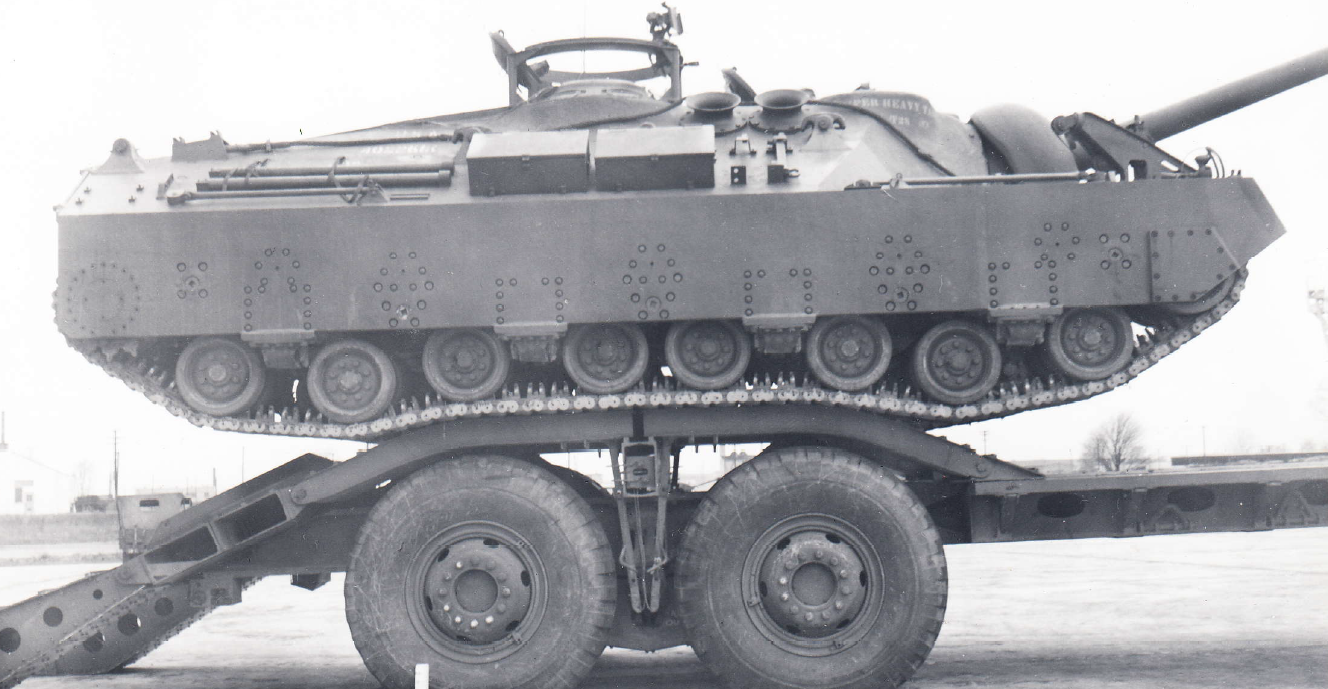
Later in the year, Ordnance brought up two other developments in the heavy tank program. These were heavy tanks T29 and T30 and were based on a chassis similar to that of the T26 series. The T29 was intended to mount the 105mm gun and the T30 to mount a 155mm gun. The weight of these tanks would be approximately 60 tons, the additional weight over that of the T26 series being attributable to the heavier turret armor and heavier armament. The hull armor was equivalent to that of the T26 series. A 23-inch track with extended end connectors was contemplated. Here again, as in the M4 series of tanks, extended end connectors would be only an expedient and could in no sense be considered an answer to the problem of lower ground pressure. On the other hand, a recently developed Ford V12 engine of 750 horsepower, with a cross-drive transmission, would provide the tanks with a modern power pland.
This program was disappointing to the Armored Board, the Armored Medical Research Laborary [Chieftain’s Note: AMRL was involved with evaluating vehicles from the ergonomic/usability standpoint], and Headquarters, Army Ground Forces. All of these agencies believed that Ordnance was approaching the problem from the wrong standpoint. It was the desire of Ground Forces to develop better, but not necessarily bigger tanks, to arm these tanks with harder-hitting, but not necessarily bigger guns, to increase power and mobility without increasing unit ground pressure, and not to increase armor unless an increase in fire power was also achieved without significant increase in ground pressure. Both of the weapons designed for these tanks had lower muzzle velocities than the 90mm gun M3, then used in the T26 tank, and both required separate loading ammunition. This last factor alone would have been sufficient to arouse Army Ground Forces’ condemnation. The difficulties of servicing tank cannon in the restricted space of a turret are serious enough without adding the complication of separate loading ammunition requiring hand or automatic ramming. The weight of the 155mm projectile (100 pounds) also exceeded the practical limits for one-man loading. The total of these objections meant a reduced rate of fire, less ammunition stowage, greater fatigue factors in the gun loaders, and fire power increased only through mass and not muzzle velocity.
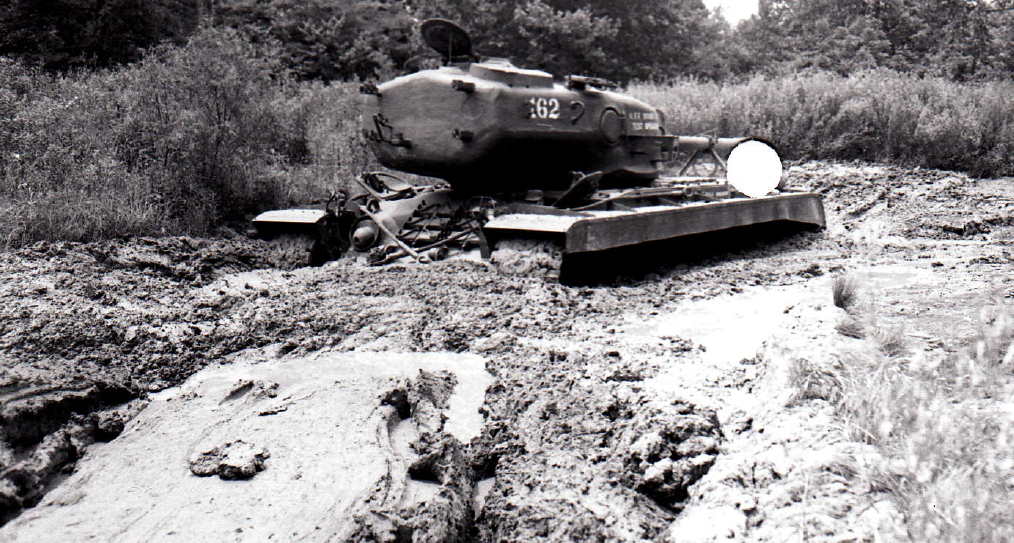
Floatation is imporant. The white circle was the result of some savage not caring where the hole punch would go.
All of these objections were pointed out in a qualified concurrence in which Army Ground Forces agreed to the construction of two pilot models of each type for development and engineering purposes only. For one thing Army Ground Forces desired to obtain data on the performance of the V12 engines in such heavy tanks and the suitability of the cross-drive transmission. It was stated definitively that no known requirement existed for either of the vehicles.
To counter this recurring tendency to build only bigger and not better tanks, Army Ground Forces supplied military characteristics for a new medium tank in September 1944. These were based on the desires of the theaters and the experience of the using arm. The characteristics were not as spectacular as those of the mammoth T28, T29 and T30, but they were designed to provide a vehicle that would accomplish what the armored people wanted. Detailed characteristics, occupying fourteen pages, were prepared, which analyzed the qualities desired in physical characteristics, performance, armor basis, armament, fire control, engine and drive, running gear, turret, stowage, communications, fuel system, vision, ventilation, gas protection, hatchways, seats, driving controls, lighting, and other similar components and accessories. Individually, the characteristics did not present a radical departure from those of existing tanks, but considered collectively, they sketched a vehicle admirably adapted to its intended purpose in every detail.
The development of this tank centered on the provision of a suitable gun to be designed specifically for the space limitations imposed by tanks, with as short a chamber as possible, as short a distance from trunnnions to breech as consistent with a balanced turret, compact recoil mechanism, short recoil and semi-automatic breech. With a caliber not to exceed three inches, it was to be capable of penetrating eight inches of armor at 1,000 yuards on a 30 degree obliquity using special ammunition. For comparison, the 90mm gun M3 firing standard ammunition (23 ½ pounds) at a muzzle velocity of 2,650 foot-seconds penetrated 4.4 inches of armor under the same conditions, with the newer HVAP ammunition (tungsten carbide core) at 3,350 foot-seconds it penetrates 6.8 inches. The German 8.8cm gun, firing a 22-pouind projectile at 3280 foot-seconds penetrates 6.5 inches, and using the new German tungsten carbide core ammunition reaches a muzzle velocity of 3,775 foot-seconds and was rated at 7.6 inches of penetration.
Ammunition for the weapon was to be fixed and to not weigh more than 35pounds. An integrated fire control system with complete stabilization was called for which would include a built-in range-funder, an auxiliary sight changeable from three to eight power, and a seven-power periscopic binocular. Army Ground Forces called attention to the fact that provision of gun and ammunition was one of the most important features of the design.
The vehicle was to weigh approximately 45 tons with an overall width of 134 inches. It was to have a ground pressure of 7 points per square inch, carrying a minimum of 6 inches of armor on the front hull and turret.
The Ordnance reaction was immediately unfavorable. It claimed that the basic features were not much different from T26E3, T26E4 and T26E5, except that some of the latter had more armor and armament. To the Ordnance Department it appeared that for the most part current developments had surpassed the ideals proposed by Army Ground Forces. Army Service Forces accepted the Ordnance contention that all of the components sought by Army Ground Forces were under development and that as these were developed and tested they should be used later in a final tank design.
Actually, the statement of Ordnance created a false impression with respect to some of the most important characteristics. No medium or heavy tank under development had as low a ground pressure as seven pounds. No gun under development fired fixed ammunition of three inches or less caliber with armor penetrative qualities specified by Army Ground Forces. Finally, no tank under development possessed a completely integrated fire control system desired for this tank. What is more important, no tank was under development as a unit which would incorporate all the desired features. The core of the proposal was for development integrated from the start rather than piecemeal incorporation. But for the time being, the proposal was not taken up.
Army Ground Forces followed up this proposal by recommending that the T26 series be modified to incorporate eight inches of armor, the 750 horsepower Ford V12 engine, and the cross-drive transmission which were to be used in the T29 and T30 tanks. Additional flotation was to be provided by adding another bogie wheel on each side. Ordnance concuirred, the tank was designated T32, and authorization given for the construction of four pilot models.
Introduction of the T26E3 tank.
By the end of 1944, while the development programs for the new heavy tanks mentioned above were being thrashed out between Army Ground Forces and Ordnance, the tests of the T26E1 had been substantially completed, and it was found that such extensive modifications were necessary that the improved tank should be given a new designation. This was done by Ordnance Committee action and the modified tank was designated T26E3. At the same time, two pilot models with the 105mm howitzer were authorized and designated T26E2. This same action terminated all development programs for the earlier T20 series except the T23 series, the T25 electric drive, and the T26 electric drive, which Ordnance still hoped to bring into the picture.
In February 1945, the first twenty of the T26E3 tanks were used in combat by the 9th and 3rd Armored Divisions in the assault of the Roehr River Line. The introduction of these tanks was observed by the mission headed by General Barnes. Initial reports were exceptionally favorable, but after further use during the spring of 1945, a better evaluation of the tanks could be made. As Army Ground Forces had always recognized, the T26E3 was far from being the complete answer to the desires of armored units even after the many improvements incorporated on its recommendations. The using troops objected to the reduced mobility and felt that added armor was still not sufficient for the tactical employment of such a tank. The 90mm gun was received enthusiastically as a substantial improvement over the 76mm gun. The tank was found to be fairly reliable although a number of minor deficiencies were experienced. It was standardized in April 1945, but the war ended before great numbers of these tanks were used and a complete battle evaluation could not be obtained. Even so, further immediate improvements were to stem from this basic vehicle.
Later Tank Developments.
In 1944, Ordnance had under development a longer-barrelled 90mm gun (T15) than the M3 (Used in the T26E3) which produced a muzzle velocity of 3,200 foot-seconds with 24-pound standard ammunition, and 3,800 foot-seconds with a 16-pound tungsten carbide shell still under development (T30E16). At 1,000 yards and 30 degree obliquity, the former shell was calculated to penetrate 5.6 inches of armor and the new tungsten carbide shell 8.7 inches. This gun with the new projectile was the closest approach to the requirement established by Army Ground Forces for a medium tank cannon, and a limited procurement of 100 was authorized. It had two serious defects. The ammunition was semi-fixed instead of fixed, and its recoil system was not as compact as desired. Although Ordnance termed the gun “super velocity”, its muzzle velocity was only comparable to that of the new German 8.8cm PaK 43 – and the latter had already been in combat use for some months.
The turret mounting of the new gun was purely an expedient, and Army Ground Forces believed a new turret should be developed. Accordingly, Army Ground Forces did not concur in a proposal to procure 1,000 T26E3 tanks, equipped with this gun and re-designated T26E4, and procurement was fixed at 100, to accord with the initial procurement of the guns.
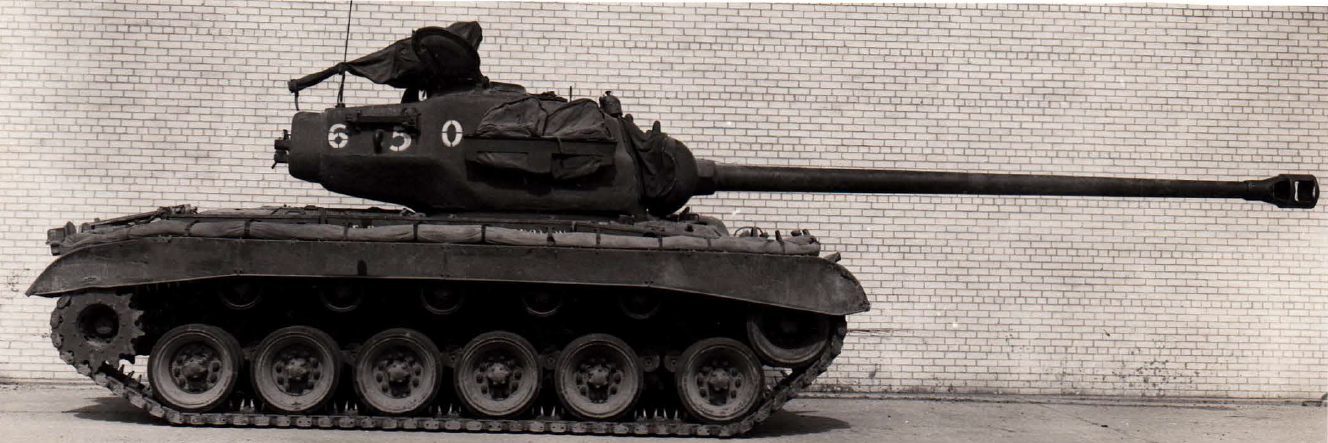
In addition to its proposal to develop the T32 tank, Army Ground Forces made a further effort to obtain a completely integrated tank and tank destroyer program for Ground Forces. In a comprehensive memorandum to the Chief of Staff, it reiterated its principle that greater striking power, but not necessarily a larger gun, was needed. It reiterated the original doctrine of General McNair that in the race between gun and armor, the gun will win, and that tanks should be opposed by tank destroyers relying primarily on mobility and a more powerful gun than the tanks they were fighting. It was admitted that tank battles became inevitable and that therefore our tanks should have guns and armor making them more than a match for any enemy tank. It emphasized the fact that even the new T15 90mm gun, which would not be ready until July 1945, would still have a lower velocity than the German 88, and it repeated the desire of Army Ground Forces to have a gun specifically designed for tank use which would penetrate 8 inches of armor at 1,000 yards. Army Ground Forces admitted that the accuracy of our tubes exceeded that of the German high velocity cannon (a fact emphasized by Ordnance) but pointed out that the life expectance of the tanks in combat was much less than the tube life of the gun. Consequently, guns of shorter life could be provided so that life expectancy of tanks and their weapons would be more in accord. Characteristics were prepared for light tanks, medium tanks, heavy tanks, and a heavy tank destroyer, all based on the performance characteristics of the weapons to be mounted. The vehicle was to be built around the gun, rather than the reverse – the principle followed under Ordnance programs.
At about the same time (January 1945) the New Developments Division of the War Department prepared a study on tank and anti-tank weapons which contemplated the standardization of the T26E3, construction of a thousand T29 and five hundred T30 tanks, and even went so far as to propose the development of a heavy tank mounting an 8-inch gun. Army Ground Force’s reply to this study was in the same tenor as its own development program.
A conference was held by New Developments Division in an attempt to reconcile conflicting aims. Ordnance objected to using the T15 90mm in all of the T26 tanks although Army Ground Forces had emphaised that its HE effect was the same as that of the M3 90mm, and its armor penetrative performance much better. It was agreed finally to include 1,000 of these guns in the 1945 program. The conference also agreed on the production of twelve hundred T29 tanks. General Barnes urged comparable procurement of the T30. He argued that it should be used to support the 105mm tanks in much the same way as the 105mm howitzer tanks lent artillery support to the 76mm M4s. General Borden supported General Barnes on this point, but General Maxwell (G-4) supported the objections of Army Ground Forces. It was agreed that Army Ground Forces would restudy possible requirements for the T30 in the light of General Barnes’ “tactical concept”. After objection by the other conferees, New Developments withdrew its recommendation for an 8-inch gun tank. General Barnes promised also to provide mechanical loading for the T30 tank.
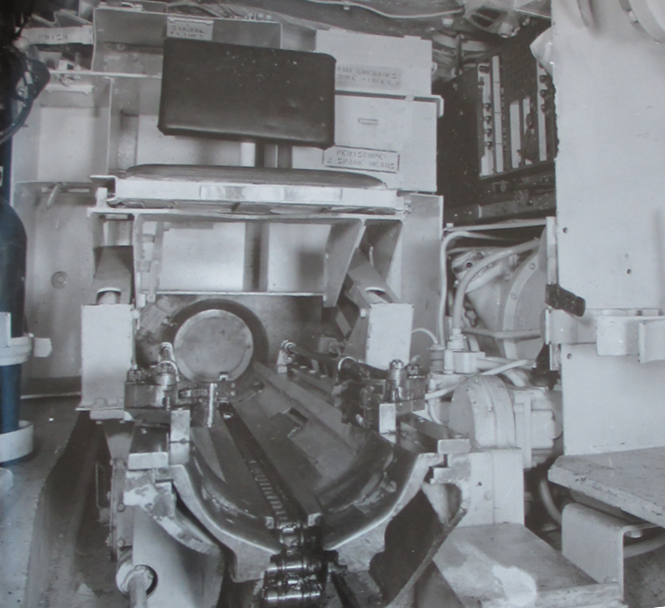
T30E1's ramming system
As directed by the conference, Army Ground Forces restudied the T30 tank. It concluded that it should not be put into limited procurement. The weapon had less accuracy and less armor effect than the 105mm. ETO had also begun to swing away from “supporting tanks” by reducing its ratio of howitzer to gun tanks. Army Ground Forces believed that if the T30 proved suitable after service tests, a portion of the production of the T29 could better be converted. Also Army Ground Forces had proposed that additional fire power in the T30 tank could much better be obtained by a gun that was a more effective “hole puncher”, and suggested consideration of adapting the 120mm AA Gun M1 for this purpose. This weapon fired a 50-pound projectile at 3,100 feet per second as compared with the 100-pound projectile and the 2,200 foot-second velocity of the 155mm gun. Ordnance replied that such development had already been undertaken and the tank designated Heavy Tank T34.
On recommendation of the New Developments Division, the War Department directed procurement of 504 of the T30 tanks although Army Ground Forces’ non-concurrence was duly recorded at the Ordnance Technical Committee meeting. The Engineers also refused to concur because of the excessive weight and width of the vehicle which exceeded allowable limits of AR 850-15, even after its recent revision.
Gradually, the T28 dropped from the picture. Recognizing the fact that it was not really a tank, Ordnance Department changed its nomenclature to Carriage, Motor, 105mm Gun T95. On this subject General Hodges wrote a personal letter to General Barnes in which he stated that there was no requirement for such a super-heavy tank and that for practical purposes the T26E4 had the maximum weight and width for anything but a strictly defensive operation. At the termination of hostilities, the pilot model of this vehicle had not yet been completed.
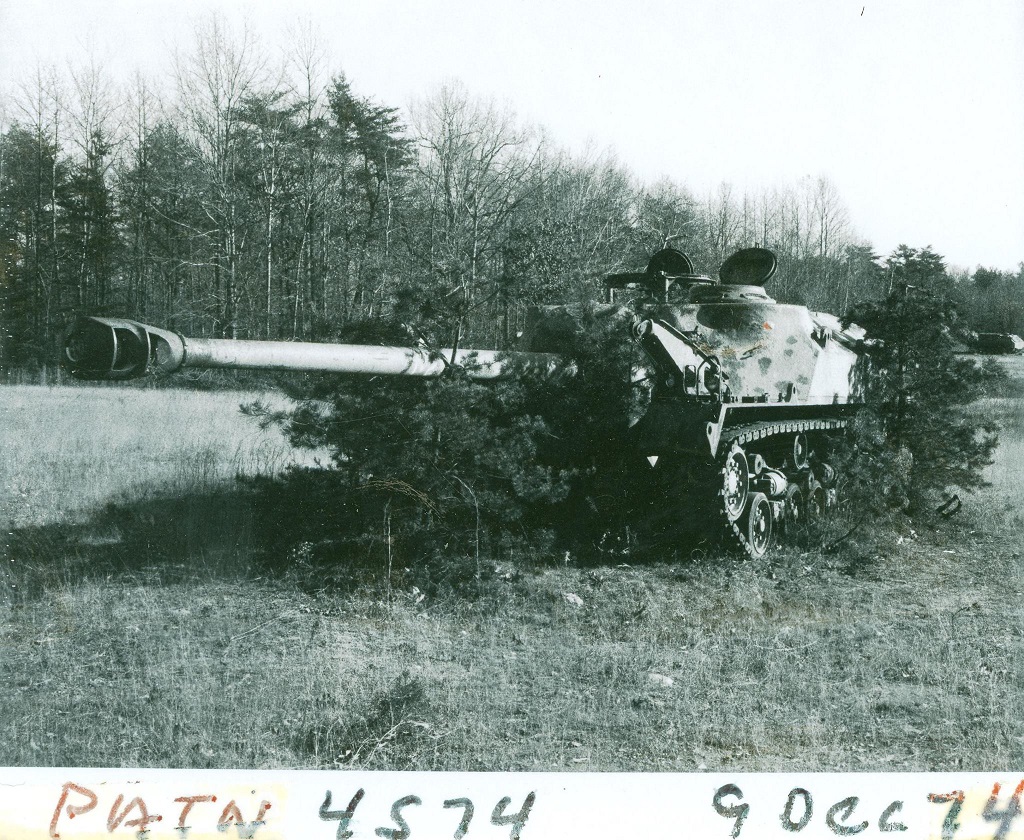
The program recommended by Army Ground Forces for better tanks did not meet with success. General Campbell, speaking for the Ordnance Department, assured Army Ground Forces that they would develop materiel desired by Army Ground Forces. But it was hard to believe that the AGF was being supported with full co-operation from Ordnance. After the passage of almost a year, personnel still either was not available or had not been made available to initiate these projects. By V-J Day, Ordnance Technical Committee actions had not even been instituted.
_________________________________________________
So that brings us to the end of the War. In the final part of this series, we'll go over the summary overview, and I'll throw in a few cents of my own.
As ever, my Facebook page remains here, my Youtube channel here, and Twitch stream (Every Tuesday, and (very) occasional evenings) is here.
